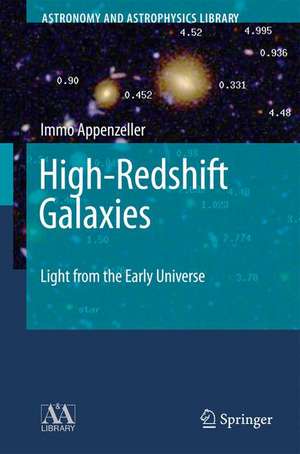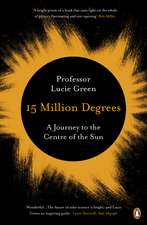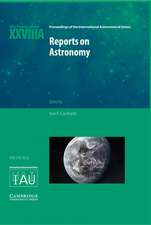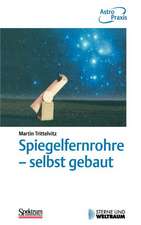High-Redshift Galaxies: Light from the Early Universe: Astronomy and Astrophysics Library
Autor Immo Appenzelleren Limba Engleză Hardback – 9 iul 2009
| Toate formatele și edițiile | Preț | Express |
|---|---|---|
| Paperback (1) | 700.29 lei 6-8 săpt. | |
| Springer Berlin, Heidelberg – 23 aug 2016 | 700.29 lei 6-8 săpt. | |
| Hardback (1) | 647.40 lei 3-5 săpt. | |
| Springer Berlin, Heidelberg – 9 iul 2009 | 647.40 lei 3-5 săpt. |
Din seria Astronomy and Astrophysics Library
- 17%
 Preț: 496.37 lei
Preț: 496.37 lei - 15%
 Preț: 603.58 lei
Preț: 603.58 lei - 19%
 Preț: 455.24 lei
Preț: 455.24 lei - 17%
 Preț: 525.72 lei
Preț: 525.72 lei - 13%
 Preț: 393.37 lei
Preț: 393.37 lei - 19%
 Preț: 524.14 lei
Preț: 524.14 lei - 17%
 Preț: 393.90 lei
Preț: 393.90 lei - 15%
 Preț: 541.54 lei
Preț: 541.54 lei - 17%
 Preț: 362.70 lei
Preț: 362.70 lei - 18%
 Preț: 1006.55 lei
Preț: 1006.55 lei - 18%
 Preț: 745.33 lei
Preț: 745.33 lei - 15%
 Preț: 641.20 lei
Preț: 641.20 lei -
 Preț: 397.38 lei
Preț: 397.38 lei - 15%
 Preț: 598.21 lei
Preț: 598.21 lei - 15%
 Preț: 658.05 lei
Preț: 658.05 lei - 23%
 Preț: 815.07 lei
Preț: 815.07 lei -
 Preț: 409.89 lei
Preț: 409.89 lei - 15%
 Preț: 610.61 lei
Preț: 610.61 lei -
 Preț: 393.90 lei
Preț: 393.90 lei - 15%
 Preț: 655.27 lei
Preț: 655.27 lei - 18%
 Preț: 951.47 lei
Preț: 951.47 lei - 18%
 Preț: 960.42 lei
Preț: 960.42 lei - 18%
 Preț: 1397.68 lei
Preț: 1397.68 lei - 18%
 Preț: 959.98 lei
Preț: 959.98 lei - 18%
 Preț: 1012.08 lei
Preț: 1012.08 lei - 15%
 Preț: 481.03 lei
Preț: 481.03 lei - 15%
 Preț: 672.43 lei
Preț: 672.43 lei -
 Preț: 413.15 lei
Preț: 413.15 lei - 18%
 Preț: 1554.72 lei
Preț: 1554.72 lei - 18%
 Preț: 1410.63 lei
Preț: 1410.63 lei -
 Preț: 390.08 lei
Preț: 390.08 lei - 18%
 Preț: 944.99 lei
Preț: 944.99 lei - 19%
 Preț: 502.94 lei
Preț: 502.94 lei - 15%
 Preț: 654.12 lei
Preț: 654.12 lei - 24%
 Preț: 851.62 lei
Preț: 851.62 lei - 19%
 Preț: 515.32 lei
Preț: 515.32 lei - 15%
 Preț: 663.14 lei
Preț: 663.14 lei - 15%
 Preț: 656.43 lei
Preț: 656.43 lei - 18%
 Preț: 741.68 lei
Preț: 741.68 lei - 15%
 Preț: 647.40 lei
Preț: 647.40 lei -
 Preț: 388.90 lei
Preț: 388.90 lei - 18%
 Preț: 1217.72 lei
Preț: 1217.72 lei - 15%
 Preț: 651.51 lei
Preț: 651.51 lei - 15%
 Preț: 655.27 lei
Preț: 655.27 lei -
 Preț: 347.59 lei
Preț: 347.59 lei - 18%
 Preț: 794.39 lei
Preț: 794.39 lei
Preț: 647.40 lei
Preț vechi: 761.65 lei
-15% Nou
Puncte Express: 971
Preț estimativ în valută:
123.88€ • 129.69$ • 102.50£
123.88€ • 129.69$ • 102.50£
Carte disponibilă
Livrare economică 15-29 martie
Preluare comenzi: 021 569.72.76
Specificații
ISBN-13: 9783540758235
ISBN-10: 3540758232
Pagini: 400
Ilustrații: XIV, 352 p.
Dimensiuni: 155 x 235 x 23 mm
Greutate: 0.61 kg
Ediția:2009
Editura: Springer Berlin, Heidelberg
Colecția Springer
Seria Astronomy and Astrophysics Library
Locul publicării:Berlin, Heidelberg, Germany
ISBN-10: 3540758232
Pagini: 400
Ilustrații: XIV, 352 p.
Dimensiuni: 155 x 235 x 23 mm
Greutate: 0.61 kg
Ediția:2009
Editura: Springer Berlin, Heidelberg
Colecția Springer
Seria Astronomy and Astrophysics Library
Locul publicării:Berlin, Heidelberg, Germany
Public țintă
ResearchCuprins
I The Context.- The Nearby Universe.- The Past and the Future.- II Methods and Tools.- Basic Techniques and their Limitations.- Finding Very Distant Galaxies.- Deriving Physical Parameters.- III Observational Results and their Interpretation.- Observed Properties of High-redshift Galaxies.- The Space Distribution of High-redshift Galaxies.- Interactions with the Intergalactic Medium.- Implications.- IV An Outlook to the Future.- Ongoing Work.- Future Facilities and their Opportunities.
Recenzii
From the reviews:“This ambitious book aims to summarize our view of high-redshift galaxies and their contents. … He describes how to find high-redshift objects, how to characterize them, how to deal with selection effects, and so on. … Appenzeller has done a fine job in summarizing the study of high-redshift galaxies and this will act as an excellent introduction to the subject for students and researchers.” (Paul O’Brien, The Observatory, Vol. 130 (1214), February, 2010)
Notă biografică
Prof. Immo Appenzeller is the emeritus director of the Heidelberg Observatory (Landessternwarte Heidelberg). From 1994 - 1997 he served as General Secretary of the International Astronomical Union. He was PI or CO of various large national and international instrumentation and research projects. His current main research topics are very distant (young) galaxies, active galaxies and QSOs, massive luminous stars, cosmic X-ray sources, astronomical instrumentation.
Textul de pe ultima copertă
This book provides a comprehensive account of the scientific results on high-redshift galaxies accumulated during the past ten years. Apart from summarizing and critically discussing the wealth of observational data, the observational methods which made it possible to study these very distant and extremely faint objects are described in detail. Moreover, the technical feasibilities and physical limitations for existing and for future ground-based and space-based telescopes are discussed. Thus, apart from summarizing the knowledge accumulated so far, the book is designed as a tool for planning future observational and instrumental programs and projects.
In view of the potential importance of the observational results of the high-redshift universe for basic physics the book is written for astronomers as well as for physicists without prior astronomical knowledge. For this purpose it contains introductory chapters describing the basic concepts and notations used in modern astronomy and a brief overview of the present knowledge of the local universe. The individual chapters provide detailed information, summaries and references on all important aspects and problems pertaining to the subject. The objective of the book is therefore to provide a thorough introduction to the topic for interested researchers. Students interested in extragalactic astronomy will find important information not (yet) available in standard academic texts. The book will also be a valuable companion text for special lectures on the high-redshift universe and cosmic evolution. And it will be an important tool for research students starting a thesis in the field of extragalactic astronomy and observational cosmology.
In view of the potential importance of the observational results of the high-redshift universe for basic physics the book is written for astronomers as well as for physicists without prior astronomical knowledge. For this purpose it contains introductory chapters describing the basic concepts and notations used in modern astronomy and a brief overview of the present knowledge of the local universe. The individual chapters provide detailed information, summaries and references on all important aspects and problems pertaining to the subject. The objective of the book is therefore to provide a thorough introduction to the topic for interested researchers. Students interested in extragalactic astronomy will find important information not (yet) available in standard academic texts. The book will also be a valuable companion text for special lectures on the high-redshift universe and cosmic evolution. And it will be an important tool for research students starting a thesis in the field of extragalactic astronomy and observational cosmology.
Caracteristici
Very timely book on very active research field with relevance to Cosmology and Fundamental Physics Provides a comprehensive account of the scientific results on high-redshift galaxies accumulated during the past ten years A valuable companion text for special lectures on the high-redshift universe and cosmic evolution Serves as important tool for research students starting a thesis work in the field of extragalactic astronomy and observational cosmology Provides a thorough introduction to the topic for interested researchers Designed as a tool for planning future observational and instrumental programs and projects Written for astronomers as well as for physicists not having prior astronomical knowledge Contains introductory chapters describing the basic concepts and notations used in modern astronomy and a brief overview of the present knowledge of the local universe Includes supplementary material: sn.pub/extras










